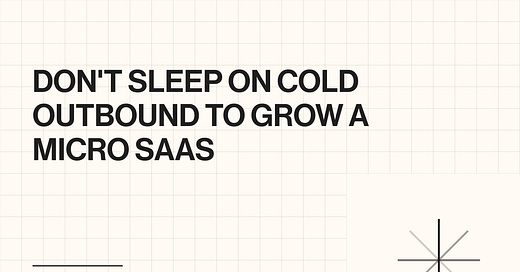🏴☠️ ⚡️ Don't Sleep on Cold Outbound to Grow a Micro SaaS (Musings)
We are Acquiring and Operating Micro SaaS firms in public. Join us every Saturday morning for acquisition deal case studies, operational tactics, growth frameworks, performance analysis, and more...
TABLE OF CONTENTS:
A Brief Overview of SaaS Growth Strategies
Evolution, Realities, and Limitations
Challenging Conventional Assumptions
Misconceptions About Sales-Led Tactics
The Case for Cold Outbound in Micro SaaS
🤔 MUSINGS
📺 WATCH:
📻 LISTEN:
A BRIEF OVERVIEW OF SaaS GROWTH STRATEGIES
Growth strategies in SaaS have evolved dramatically over the last 10yrs. SaaS companies traditionally relied on armies… errr, human sales forces (think: Oracle, Salesforce), with teams directly engaging potential clients to drive adoption and generate revenue. Sales-led growth (SLG) is no doubt effective, but it scales linearly, as do the costs. We like non-linear growth and fixed cost bases.
The rise of Product-Led Growth (PLG) marked a significant shift, proposing a model where the product itself drives user acquisition and expansion. By focusing on creating inherently valuable and user-friendly products, companies like DocuSign and Slack demonstrated the potential of PLG to facilitate rapid, viral adoption with zero human sales. That said, genuinely viral products are RARE.
For the products that don't fit this super rare profile, the concept of Product-Led Sales (PLS) emerged. PLS combines the product's ability to attract, engage, and qualify users / accounts with human sales to generate conversions to paid customers.
The world has embraced the idea that optimal growth is usually a combination, or a very thoughtful sequencing, of these models. In addition, some models better apply to a respective segment (i.e., PLG for small businesses and SLG for enterprises), so you'll see them utilized in parallel.
EVOLUTION, REALITIES AND LIMITATIONS
The Rarity of Natural Viral Growth: The expectation that SaaS products will inherently drive viral growth is a myth. Success stories like DocuSign and Slack are total outliers who evolved to include SLG as they matured. These exceptions have skewed perceptions, leading many to overestimate the potential for Product-Led Growth (PLG) as a singular cheat code that drives wild growth and widespread adoption. Recognizing this rarity is crucial; relying on PLG alone overlooks the diverse strategies necessary for sustainable growth.
Product-Led Growth (PLG) Limitations: Achieving widespread adoption solely through product-based growth loops is HARD and requires a ton of time to observe results from growth experiments (think: if we move the front door to the house, will more people come in?).
Product-Led Sales (PLS): In response to the limitations of PLG, Product-Led Sales (PLS) emerges as a strategic evolution. PLS retains the product at the heart of the growth strategy but reintroduces the human element (and cost!) at precise moments. This hybrid approach acknowledges the strengths and addresses the weaknesses of both strategies, offering a more nuanced path.
CHALLENGING CONVENTIONAL ASSUMPTIONS
BEWARE of traditional assumptions related to SaaS growth strategies in the context of Micro SaaS.
First, a niche focus does not require an extensive marketing budget or a large sales team.
Second, we can rely on something other than a product's feature set and technical superiority. While important, this perspective neglects the value of customer experience, community building, and personalized engagement, which are critical in our space. We thrive by creating SUPER dedicated user bases, which are a function of simple products that focus on solving specific problems for a well-defined audience.
Lastly, the expectation that growth must be rapid and fueled by significant venture capital investment is not always applicable to Micro SaaS businesses. Many successful Micro SaaS companies grow organically, prioritizing profitability and sustainable development over the high-speed, burn-rate-driven growth that larger SaaS entities might pursue. This slower, more deliberate path allows for a deeper understanding of customer needs and more strategic adjustments to the product and business model.
MISCONCEPTIONS ABOUT SALES-LED TACTICS
The landscape of sales-led tactics in SaaS has DRAMATICALLY transformed in the last few years. These tactics should no longer be seen as labor-intensive and costly, predicated on the belief that scaling sales efforts directly correlated with increasing headcount and, consequently, juicing costs (aka CAC). Robust automation (e.g., templated email sequences) is now table stakes. That said, the abuse of automation has broken or structurally diminished the effectiveness of many channels (e.g., email, LinkedIn).
Moreover, integrating analytics and data-driven insights into sales strategies allows for a more targeted approach, further optimizing CAC. By understanding customer behavior and preferences in real-time, SaaS companies can tailor their sales tactics to meet the needs of potential customers more precisely, enhancing conversion rates without proportionately increasing costs.
Lastly, generative AI has, again, RADICALLY transformed the cost structure while providing even better personalization at scale.
THE CASE FOR COLD OUTBOUND IN MICRO SAAS
Inbound marketing and PLG get all the love these days, though don't sleep on SLG—or at least the tactical components of SLG strategies.
Cold outbound (contacting someone via email or social, etc., without their opt-in) to a niche / highly defined customer segment is a highly productive and cost-effective way to deliver a relevant value proposition at an exciting scale.
In addition, cold outbound strategies provide control and predictability that is hard to achieve with inbound and PLG methods alone. With cold outbound, you can proactively reach out to prospects to establish a pace for growth. You can segment the market, tailor messages, and optimize outreach strategies based on real-time feedback and performance data. A data-driven approach minimizes wasted effort and enhances the effectiveness of each interaction. Put simple, low CAC, and high ROI - yeehah!
In essence, cold outbound is not a relic of the past. It presents a nuanced opportunity for Micro SaaS businesses to carve out their piece of the market by driving growth in a controlled and measurable way.



